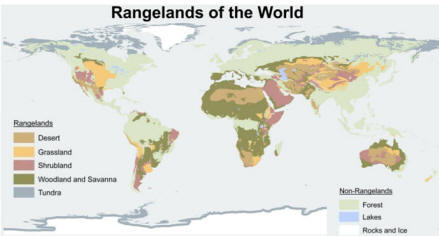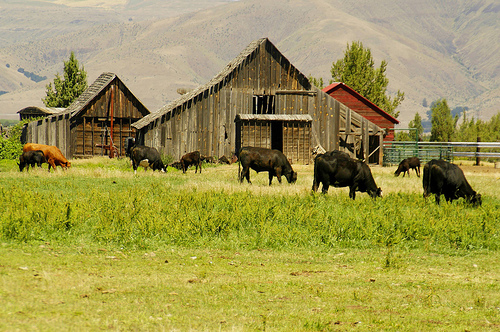“Is meat sustainable?” It’s a question too big to tackle in a single blog post, but the fact is that billions of people worldwide eat meat, in one form or another, and in the Northwest, farm sales of livestock represent nearly $3 billion in sales annually. It’s useful, therefore, to consider whether some forms of meat production are better for natural systems than others.
One promising technique attempts to use livestock grazing to reverse desertification, restore grassland habitats, and even reduce global warming. It may hold promise for the Northwest’s dry interior regions.
There’s a fascinating back story to the so-called “brown revolution” for arid lands that starts with Allan Savory, who founded the Savory Institute based on the principles he discovered while ranching in Africa. One good account comes from Spencer Beebe, who profiled the work on Ecotrust’s blog.
The guiding belief behind Savory’s work is that while overgrazing can cause desertification, there’s something to be learned from the fact that humans, grazing animals, and their habitats evolved together. For example, in arid environments today, sudden dry periods can halt the natural decay of plant material. But in prehistoric times, huge herds of grazing animals, such as buffalo or elephants, moved frequently across the landscape, in the process trampling organic material into the soil and breaking dry ground to allow water to seep in. The grazing herds also effectively “recycled” grassland forage by eating it, then returning it in the form of dung and urine. Herds moved on before they ran out of forage, which allowed the grazed area to “rest,” recover, and re-grow, thanks to water infiltration and the chewed and trampled biological material, before grazers returned to repeat the process.

Domesticated livestock and fences changed the natural dynamic, allowing private herds to graze in a single location with no recovery for the rangelands. The result was often desertification, reduced productivity and biodiversity, and increased poverty for grazing communities. The solution, Savory believes, is “holistic grazing management” that moves herds in such a way that allows more “rest” of rangelands before the herd moves in again.
Rangeland—the extensive, unforested land dominating the western half of North America—constitutes a very large portion of Cascadia. In the Northwest, the most common form of rangeland is sagebrush country, sometimes called the “shrub-steppe,” that provides habitat for sage grouse and many other creatures as well.
In Oregon, federal rangelands cover 14 million acres, fully 54 percent of the state’s land. Idaho’s rangeland covers 44 percent of the state, 9.5 million acres. By one estimate Washington’s rangeland totals about 5 million acres, representing 27 percent of the state, and British Columbia contains more than 23 million acres of rangeland––about 25 percent of its total land — and a beef herd of about 215,000 head.
On both sides of the border, government has an outsize role in controlling rangelands. In British Columbia, over 90 percent of the land is Provincial Crown (that is, government-owned) land. The government leases rangeland, with most grazing occurring on Crown land between the Canadian Rockies and the Coast Mountains.
In the US, support for grazing has been a federal function, going back at least to the New Deal-Era Taylor Grazing Act of 1934, which directed the government to manage and protect federal rangelands, and to support grazing. That function now resides with the US Bureau of Land Management, which manages huge portions of Cascadia east of the Cascade Mountains.
Because rangeland management is largely the province of Cascadia’s governments, public policy can play a leading role in catalyzing sustainable grazing practices. Before that happens, however, policymakers will need to better understand the benefits of Savory-style range management.
At Idaho State University, GIS Training and Research Center director Keith Weber has found that intense livestock grazing over a short period of time on a small area actually benefits rangeland, a conclusion consistent with Savory’s “brown revolution.” (Weber is also co-author with Sharon Horst, a Savory Institute co-founder, of an October 2011 scientific article, examining the potential for livestock grazing management to improve arid and semiarid rangeland ecosystems.)
There may even be a climate benefit to better grazing practices. In a 2011 article in the Atlantic, Jim Howell, co-founder and CEO of Grasslands, addressed the connection between livestock and global warming, claiming that increasing the organic matter in the world’s grasslands by just two percent would sequester 2880 billion tons of CO2.
For comparison, a February 2009 author in Scientific American estimated that the annual worldwide production of meat generated the equivalent of 6.5 billion tons CO2. (The analysis applied to all meat, not just livestock. However beef is one of the most greenhouse gas-intensive forms of meat.) For perspective then, if Jim Howell’s estimate is right, better managed grasslands might be able to take up all the CO2 gases produced by 443 years of meat production at current rates.
It remains to be seen whether holistic grazing will take root with Cascadia, but the practice is already at the region’s doorstep. Grasslands, LLC is applying holistic grazing practices in South Dakota and eastern Montana regions where buffalo once held sway.
It’s important to acknowledge that some have objected to Savory’s principles; see here and here, for example. In addition, it may take years before results from the Grasslands LLC operations in the Great Plains might can support the “brown revolution” hopes.
In the meantime, however, the Savory Institute has won support from organizations as diverse as Ecotrust in Portland and ranching advocates in Idaho. Here’s hoping that the Institute’s grand experiments in the Plains are successful, and can translate to more sustainable meat production and healthier Northwest rangelands.
John Abbotts is a former Sightline research consultant, who occasionally submits material that Sightline staff turn into blog posts.


Comments are closed.